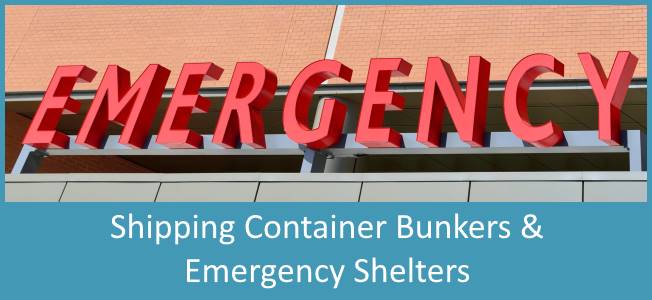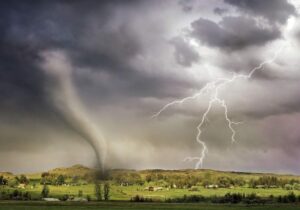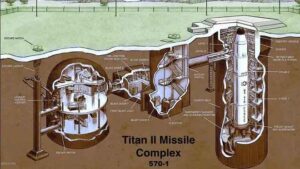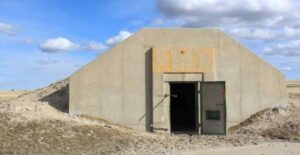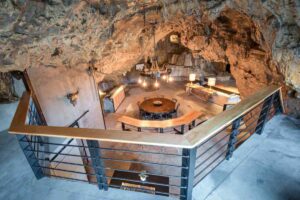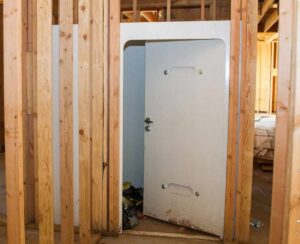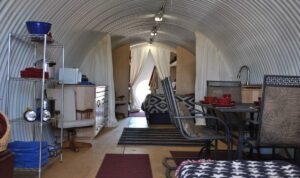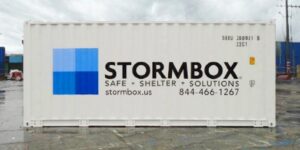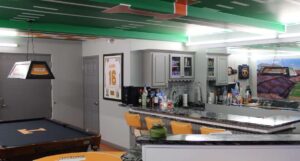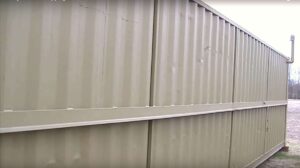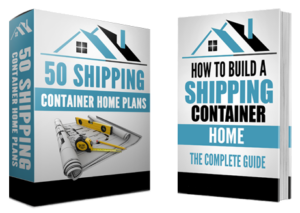The world is full of risk and danger to our normal way of life, from extreme weather events to acts of terrorism. For many people, having a durable space to store supplies and retreat into when required is a necessity. And shipping containers are a great way to build such a structure.
In this article, we’ll discuss everything you’ve ever wanted to know about shipping container disaster shelters and other types of resilient container uses. Make sure you make it all the way down to the bottom of the article to see the examples of shipping container emergency shelters.
Understanding Disaster Preparedness
No discussion of shipping container disaster shelters and similar structures is complete without understanding why you would want to build one in the first place. Understand that there are entire books and websites exclusively devoted to this topic, so our discussion below is simply an overview to ultimately help understand how shipping containers can play a role in this situation.
The Preparedness Mindset
Being prepared for an emergency is a thought process acquired over time. Some people obsess over it while others consider it a small but important part of their normal life. People who were once unconcerned with it may suddenly be awakened when they or someone they know was put in a situation that required prior preparations and some level of self-reliance.

The more extreme end of the self-sufficiency movement spectrum is captured by things like the Doomsday Preppers TV Show, who in many cases are concerned about the full collapse of society. “Preppers” are often pictured as those who take preparedness to an extreme and go to often great lengths to ensure their personal safety and survival in the worst possible situations they can imagine.
On the other end of the spectrum are people who simply want to avoid being victims in the somewhat rare but certainly possible circumstances that can come our way. Almost everyone has some level of preparedness, after all, unless you eat every meal in restaurants and drive your car around with no spare tire and an empty fuel tank!
In the middle are average people who because of personal history, research, or other reasons, have become interested in hardening their own defenses against outside threats. People who have spent time in the military, those who are avid hikers and outdoor recreation lovers, or previous members of organizations like the Boy Scouts and Girl Scouts, often have a greater appreciation for being prepared.
One group that takes the subject very seriously are Mormons (members of the Church of Jesus Christ of Latter-Day Saints), who strongly emphasize emergency preparedness and food storage. There are also a surprising amount of very wealthy and high intelligent people preparing for emergencies as well.
There are certainly fringe groups that exist in the world of home defense, survivalism, and emergency preparedness. However, there are plenty of regular people out there too that take being prepared seriously without being paranoid. We hope that wherever you currently fall, you’ll continue reading with an open mind!
Understand that most disasters don’t care about your skin color, political affiliation, or age…preparation is universally a good idea for all people. There are numerous real and possible emergencies, and odds are high that you’ll go through at least one in your life if not more.
External Risks and Threats to Mitigate
The idea of preparing for and surviving both man-made and natural disasters is based on the assumption that one might occur. Below are examples of the types of disaster events that emergency minded and survivalist people are worried about:
- Tornado and Typhoons: Extreme winds not only make it difficult to leave your house, but they also threaten your safety inside our house unless it is built especially strong.
- Hurricanes, Floods, and Tsunamis: Water coming from the sea or sky can quickly displace you from your house and force you into a survival scenario.
- Earthquakes and Landslides: These forceful natural events can damage communication lines, roads, and inadequately built structures.
- Snow and Ice Storms: In addition to the deadly cold temperatures, these weather events can also seriously impede your ability to travel in search of supplies.
- Fire: Forest and grassfires can sweep over terrain quickly destroying anything flammable in their path. Traditional homes barely stand a chance.
- Meteor Impact and Volcanoes: These rare events can cause immediate damage then continue the suffering for days as their dust and ash block the sun and make the air unbreathable.
- Nuclear, Biological, Chemical or other Terrorist Attack: Hostile actors can wreak havoc that damages public infrastructure, poisons the water supply, spreads illness, and more.
- Disease Pandemic/Epidemic: A disease that’s naturally occurring is no less dangerous as the Corona Virus of 2020, the Spanish Flu of 1918, and the Black Death of the 1300s prove.
- Economic Depression and Political Unrest: Economies and societies can actually be quite fragile. Disruption due to public policy, natural events, war, etc. can quickly erode supply chains and the normal ability to purchase things at a moment’s notice.
- Personal Unemployment: Even with no external issues from society, the loss of your own job can cause tremendous financial stress and is worthy of preparation as well.
- Crime: Things like local gangs, escaped prisoners, or other temporary spikes in criminal activity can make even leaving your home a dangerous event.
Disaster Shelter Requirements
Understanding that the risks described above are real, having a specialized structure to handle the requirements of possible emergencies is where we’ll focus next.
There are various names for what we’re talking about here:
- Bunkers: Emergency bunker, bugout bunker, doomsday bunker, etc.
- Shelters: Disaster shelter, storm shelter, bomb shelter, tornado shelter, etc.
- Rooms: Panic room, safe room, prepper room, etc.
At a high level, they are all more or less trying to do the same thing, which is to protect you from external threats and provide for your welfare while you’re inside. Obviously, each variant does so from a slightly different angle.
How well an individual solution will protect you depends on which threats you think are most probable: if you live on a Caribbean beach, snowstorms aren’t a concern but hurricanes and tsunamis should be.
Your survival bunker requirements are driven not just by what’s happening outside, but by what you need to accommodate and accomplish inside.
Below are a few things to consider across several categories:F
Timeline
The first thing to consider is, based on the risk of different disasters and emergencies in the area where you reside, how long do you want to prepare to live in your shelter? Every location is different and each person has a different amount of risk they are willing to tolerate (you can’t prepare for every possible unknown…that’s why it’s an unknown).
People often create plans to shelter-in-place for up to three days, up to two weeks, up to three months, etc. Where you make that cut off will determine not just how much stuff you need, but what stuff you need too.
Note that the Red Cross recommends planning for three days if an evacuation happens or two weeks if you shelter in place at home. Many choose to exceed these minimum recommendations.
Occupants
When it comes to actual human occupants, you need to take into consideration both quantitative and qualitative requirements. From a quantity standpoint, think about how many total people you have to feed, clothe, care for, and provide a place to sleep.
Additionally, occupant ages and capabilities are a huge factor, as it dictates both their own personal needs and their ability to contribute to the group. Finally, you have to think of things like disabilities, dietary restrictions, allergies, etc. that might require specialized supplies or accommodations.
Another consideration is pets if you have them. Pets obviously require a whole other type of planning and provisioning, depending on species.
Supplies
The people that will be inside the shelter obviously need supplies to sustain them. Below are a few examples:
- Food: You need sustenance that can last for months or even years (unless you want to continually be replacing it), that tastes decent enough to eat for weeks on end, and that provides enough calories and nutrients to keep you healthy (or also take vitamins and supplements to make up the difference).
- Clothing and Bedding: Appropriate clothes as well as sheets and blankets to keep everyone comfortable.
- Drinking-Water: If municipal water and well water is temporarily unavailable, you’ll need a supply of water to drink and cook with.
- Financial Reserves: In many of the situations above, you may need to acquire additional resources but your access to things like banks and ATMs may be limited. Having cash on hand or even additional emergency supplies to use for bartering may be useful.
- Medication and First Aid Supplies: You’ll need to be able to deal with any pre-existing conditions that occupants have upon entry to your shelter, as well as any emerging issues that appear due to illness or injury. You may also want extra if you encounter friends and neighbors that require aid.
- Sanitation and Waste Management Materials: Just like the famous book that says “Everyone Poops”, you’ll need a way to deal with human waste, food waste, greywater, etc.
- Fuel Sources: Depending on what equipment you have for climate regulation, cooking, lighting, electrical generation, etc. you’ll need some type of fuel source in case grid-provided power systems fail.
Equipment
If you could simply live in a dark cave, eat your food, and sleep until the threat is gone, you might be ok without much equipment. But in most cases, you’ll need some additional tools, gear, and prepper supplies to make your bugout shelter more habitable and comfortable. Below are a few examples:
- Communications Gear: Backup cell phones and computers are good, but in case that infrastructure doesn’t function, radios are also incredibly useful.
- Air Filtration System: Humans can go days or even weeks without food and water, but only minutes without breathable air if an emergency affects the atmosphere.
- Water Filtration System: Stored water is good, but it takes up a ton of room. For longer durations, you have to think about being able to filter water as well.
- Power Production Equipment: If you don’t go with fuel-based equipment, you have options like wind turbines, solar panels, and batteries to power your equipment.
- Cooking, Heating, and Cooling Equipment: Temperature regulation and indoor meal preparation both require specific equipment.
- Furnishings: Unless you’re staying for less than an hour, you’ll want to think about sitting and even sleeping spaces. Folding chairs and bunk beds are great ways to maximize space.
- Illumination: When indoors, it’s crucial that you have both permanent and portable illumination devices to see for daily activities.
- Physical Safety And Hunting Tools: A gun, knife, bow or other devices can be useful for both protecting occupants and acquiring additional food.
- Alternate Transportation: Maybe it’s a bicycle, maybe it’s skis, but it’s worth considering having a different means of transit available in case your primary vehicle is not available or operational.
Informational Resources
In many cases, information can be just as valuable as tangible goods. The ability to know where to go and who to call for help cannot be discounted, and your emergency plan should include locating, storing, and updating important data sources.
- Important Documents: Think of things like passports, bank account numbers, property deeds, etc.
- Annotated Paper Maps: If Google Maps isn’t working, you still need to know where to go. Paper maps should be marked with important locations like friend/family homes, water sources, emergency services, etc.
- Contact Information: It’s a good idea to have multiple means of contact for family and friends, local emergency services, the Red Cross, other public service organizations, etc.
Optional Uses
Despite planning for worst-case scenarios, odds are high you won’t use your emergency bunker often for emergencies. So, it’s prudent to think about appropriate secondary-uses for the space.
Examples include wine storage, guest rooms, exercise spaces, etc. Our She-Shed and Man-Cave article gives numerous other examples of small structures to give you some inspiration.
Whatever you decide on, ensure that your survival shelter can be quickly reconfigured back to its primary purpose: ensuring your safety. This means you can’t let it get full of clutter, etc. that would delay you in a time-critical emergency.
Benefits of Shipping Container Bunkers and Disaster Shelters
We’ve thoroughly covered why you need a security bunker and what it needs to be able to do. Now, let’s discuss some of the positive attributes of shipping containers that make them well-suited for these types of roles:
- Secure: The walls and roof of a container are made from solid steel. Even Chuck Norris couldn’t kick through one! And when appropriately locked and secured, gaining unwanted entry is a difficult and timely process.
- Durable: Containers are made to endure treacherous voyages at sea while filled with tens of thousands of pounds of products…and hundreds of thousands of pounds of filled containers stacked on top. Even unmodified, they are still much stronger than most types of traditional construction.
- Affordable: Empty containers can be purchased for just a few thousand dollars, with a little bit more to add a foundation to secure it to the ground.
- Easy to Find: Steel shipping containers are commoditized, so they are easy to find. In most parts of the world, you can get one in just a few days. There’s no waiting on a factory to build one for you or on contractors to custom-make one at your house like other shelter types.
- Airtight: Containers are so airtight that they have more condensation issues than most traditionally constructed buildings (though this is easily dealt with). If the threat of an airborne virus or biological/chemical attack is part of your concern, the last thing you want is a traditional building with air leaks.
Downsides of Shipping Container Bunkers and Disaster Shelters
Depending on the threats you want to mitigate, a container survival shelter may be the wrong choice. Below are some of the negatives of using containers. Understand that finding a structure-type without any of these negatives will be very costly, but we’ll discuss some other choices in the next section.
- External Door Locks: Container doors lock externally, which means that someone needs to shut them, then somehow still get into the container afterward. A secondary door or roof hatch can be used for this (see below). Or, you can remove the external locking mechanism from the container doors and attach an internal door bar that you can set from inside.
- Good Foundation Required: Containers may be strong and heavy, but high winds, moving water, or shifting ground can still move them as these people can attest. They need to be rigidly attached to the ground to keep them securely in place.
- Single Set of Doors: Many preppers recommend having multiple ingress/egress options in case the first door(s) is blocked by debris, etc. However, it’s easy enough to add a secondary door or roof hatch to a shipping container if you like.
- Not Very Resilient to Gunfire or Heavy Flying Debris: As discussed in our Container Dimensions article, the corrugated metal skin of a container is typically around 1.5 – 2mm thick. When it comes to bullets, a container can stop a .22lr but usually not larger caliber ammunition. And high-speed debris in a tornado or hurricane situation can definitely leave a dent in a container (and something sharper might pierce it).
- Not Good for Underground Shelter Use: Building underground certainly affords you more protection from many threats (though it does introduce others like flooding and radon gas), but doing it with a container is another thing entirely. We’ve said it before: containers should NOT be used underground without extensive structural modifications. If you want a buried structure, you’re usually better of going with something tailor-made for that purpose (see below).
Other Emergency Shelter Options
The world of survival bunkers, safe rooms, and fallout shelters includes quite a wide variety of construction types and acquisition possibilities. So before we showcase shipping containers shelter examples, let’s first cover a few other options for comparison.
Common construction methods include concrete and steel, whether freestanding or subterranean. Here are some examples:
Missile Silos, Telecommunication Bunkers, and Military Facilities
The United States Government constructed hundreds of underground missile silos throughout the country during the Cold War, housing Atlas E, Atlas F, Titan I, Titan II and Minuteman missiles. Most are now unused and in private ownership. Built for millions of dollars each, these buildings are extremely secure.
There are also countless above and below ground buildings built for telecommunication purposes. They formerly housed equipment for underground cables or radio towers and were built securely to ensure that communications could continue regardless of weather conditions. These too can be found for much less than their cost of construction.
In the US, companies like 20th Century Castles and Survival Realty can help you locate such properties.
But, these types of structures aren’t just in the United States. For instance, did you know that Albania has over 173,000 concrete bunkers? There may be similar types of hardened structures located near where you live as well.
Shared Ownership Shelters
If you like the idea of having access to a secure shelter, but don’t have the resources or land to have one at your current home, there are other options. Several companies now sell memberships and partial ownerships of larger, shared facilities. Some of them make use of previous military buildings like those discussed above, while others are purpose-built.
Vivos is repurposing the hundreds of ordnance storage bunkers at the former Black Hills Ordnance Depot into secure bunkers for sale. These buildings are above-ground but are earth-sheltered, meaning dirt is piled beside and on top of them for additional protection.
Or, there are facilities that were constructed with survival scenarios in mind, like the Fortitude Ranch. Another option is leasing space in an existing, privately owned bunker through the Bunker Network.
Repurposed Caves, Mines, and Quarries
These existing subterranean spaces make great places to store supplies and survive emergency situations. Included in the category are natural caverns and man-made excavations created in search of minerals.
Some, like the Beckham Creek Cave above, have been turned into huge, luxury accommodations. It can be rented by the night and is basically an entire home inside a security bunker.
Others are huge complexes that are used for commercial purposes. At one time, such as during the Cuban Missile Crisis, some of these larger facilities were also planned for survival bunkers and national stockpiles as well. Numerous examples exist all over the world. In the US, a few examples include the SubTropolis, the Louisville MegaSpace, the Bussen Underground Warehouse, the Atchison Storage Facility, and the Marengo Warehouse.
Personal Shelters
If you want a personal shelter, on your property, just for you and your immediate family, you have a number of options. Dozens if not hundreds of companies exist to provide everything from closet-size safe rooms that you can place inside your house to family-sized underground rooms. There are even options you place beneath your garage!
These safe spaces can be made of precast concrete, poured-in-place concrete, structural steel, or even corrugated steel culverts. The options are really only limited by your budget and imagination. Several of the major players in this space include Atlas Survival Shelters, Rising S Bunkers, and Ground Zero Shelters.
Shipping Container Bunker Examples
There are a variety of ways that steel shipping container shelters can be built. Some are just bare-bones structures intended only to keep threats out and nothing else. Others have had a lot of effort placed into making them pleasurable spaces to occupy. The below examples demonstrate how flexible containers are for purposes of building a safe space.
Stormbox
Stormbox creates aboveground storm shelters from specially modified shipping containers. They are engineered and tested for survivability from F5 Tornadoes and Category 5 hurricanes thanks to their internal reinforcement and strong anchors to a thick concrete slab.
Henson Construction Safe Zones
Henson Construction builds what they call Safe Zones, which are multipurpose shelters built from shipping containers. However, the interior and exterior surfaces of the container are covered so that there is almost no indication that a container is underneath. Yet, the strength and resiliency of containers is at the core of these buildings.
The safe zone shown in the above photo was created to be a University of Tennessee themed man-cave, complete with wet bar, pool table, and multiple TV screens. Yet, the room is also extremely secure and goes to show that safe rooms don’t have to be boring.
Safety Bunkers
Safety Bunkers creates a variety of both aboveground and belowground storm shelters. They do use shipping containers for some of their products, both others are custom designed out of metal.
The above example demonstrates how they provide both horizontal and vertical structural enhancements to the exterior of their container bunkers. Additionally, there are also interior reinforcements as well. Together, these additional supports transform a regular shipping container into a building that can endure greater stress from extreme weather and other events.
Friend School Storm Shelter
The Friend School in Chickasha, Oklahoma is right in the middle of an area of the US with high tornado activity. Worried about their normal plan of busing students to a nearby church basement in case of severe storms, the school looked for an economical storm shelter alternative.
With the help of a local architect and community donations, they built the Mark Henderson shelter out of four 40ft shipping containers. The containers were modified and then earth-bermed to provide additional protection from the tornados that frequent the area.
Summary
This article certainly wasn’t meant to scare or worry anyone. Rather, it is meant to highlight a growing trend of people who are concerned about their safety and wellbeing and are choosing to be proactive.
Life is all about choices, risks, and knowing what you can control. For some, making the types of preparations discussed in the article may seem too extreme. For others, it’s impossible to be too careful.
Regardless of where you draw your own boundaries for personal security and safety, we’ve now shown a light on the types of risks and emergencies that are potentially out there for you. We also hope that you now have a general understanding of the types of preparations and shelter options that are available to you.
Whether a shipping container should be the basis of your own emergency room is a personal choice that depends on a variety of factors like your resources, alternatives, and most probable risks. But armed with the information in this article, you can make a much more informed decision about the safety of you, your family, and your neighbors.
Do you know of another shipping container shelter that we’ve overlooked? What do you think about managing risks and the cost to do so? Let us know in the comment below.

